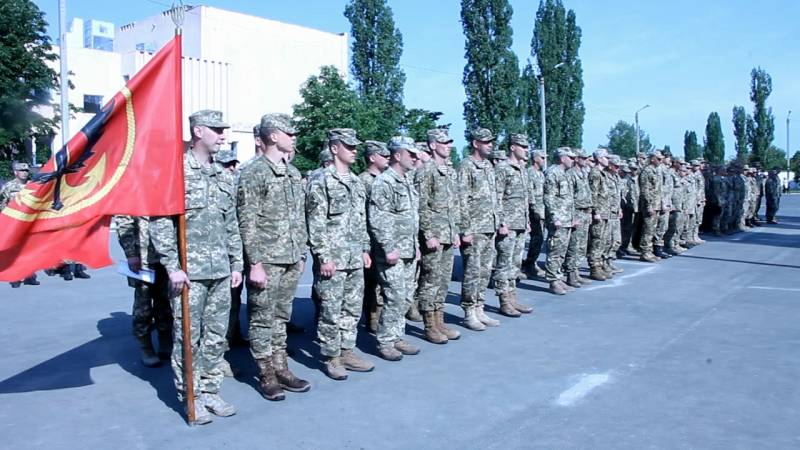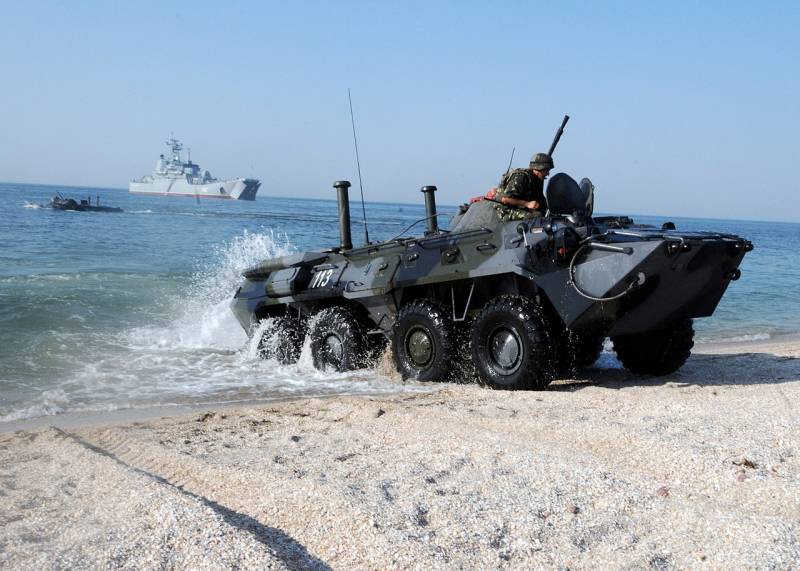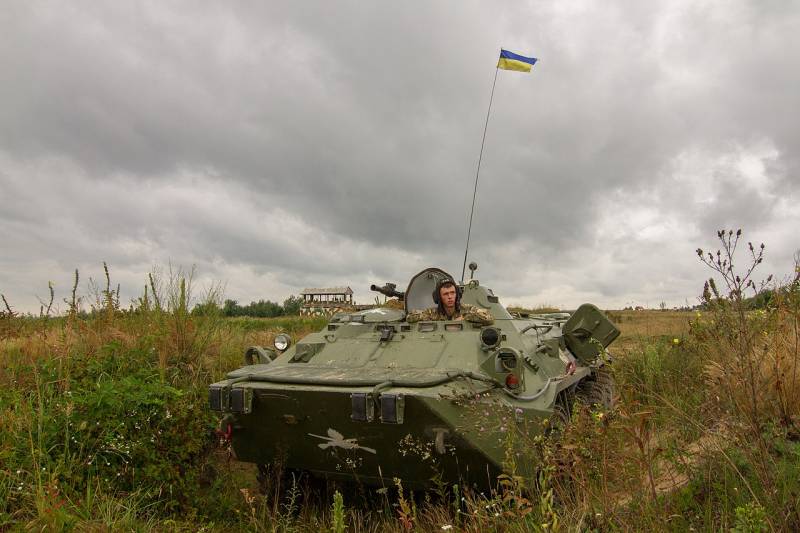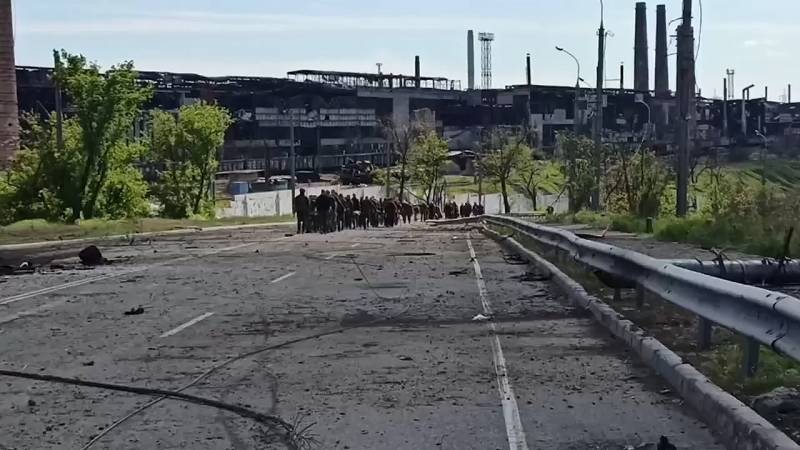Marines of the Ukrainian Navy: objective restrictions and forced demilitarization
The basis of the coastal troops of the Ukrainian Navy is the Marine Corps. In recent years, the command has been actively developing this type of troops, seeking to increase its combat effectiveness and make it the elite of the armed forces. However, the events of recent months have shown the real results of these processes. Despite all efforts, the capacity remained at an insufficient level, and forced demilitarization further reduced it.
The initial state
The marines are the backbone of the coastal troops of the Ukrainian Navy and are called upon to solve various tasks on the coast and in the coastal zone. It includes infantry, tank, artillery and support units and units. In addition, interaction with other forces and means of coastal defense is envisaged.
The Ukrainian marines are not distinguished by large numbers. At the beginning of this year, it served approx. 6 thousand people It is noteworthy that such indicators have been achieved only recently, based on the results of last year's recruitment and training of personnel. At the same time, according to some reports, far from all the needs of the troops were covered.
The organizational structure of the Marine Corps is quite simple. There is a command of the type of troops under the command of the Navy. He has two brigades and two separate battalions of marines under his command. These units and formations have all the necessary units, forces and means for various purposes.
The 35th Separate Marine Brigade (35th Marine Corps) is based in the Odessa region. It includes three battalions, each of which includes a headquarters, three companies of marines on amphibious vehicles, as well as companies and platoons of reconnaissance, support, etc.
In the Nikolaev and Zaporozhye regions, as well as in the occupied territory of the DPR, units and subunits of the 36th Marine Corps were deployed. This brigade includes three battalions of marines, as well as a tank battalion, a brigade artillery group, an anti-aircraft battalion, companies of snipers, electronic warfare, RKhBZ, etc.
The 137th and 503rd separate marine battalions have their own headquarters and include two companies of marines and one air assault company. They also have two or three artillery batteries, anti-aircraft, engineering, etc. platoons. Support and supply units are provided.
Material part
For obvious reasons, the basis of the fleet of equipment and armaments of the Ukrainian marines until now were products of the old Soviet production. Attempts to independently modernize and re-equip did not give noticeable results. In 2014-15 foreign materiel began to enter the units, but even she could not radically change the situation.
Until recently, armored personnel carriers and combat vehicles of outdated models with amphibious capabilities, such as the BTR-60 or BTR-80, as well as the BMP-1, were the most mass-produced equipment of the Marine Corps. In recent years, the troops have received limited quantities of Cossack and Warta armored cars, but they have not had a significant impact on the overall condition of the fleet.
The tank battalion of the 36th Marine Corps was armed with the main tanks T-64BV and T-80BV in the amount of approx. 70 units Apparently, these machines were built before the collapse of the USSR and were distinguished by their great age. Plans were reported to modernize or even replace such equipment, but real measures never followed.
Artillery battalions were also equipped with old weapons. They had D-20 and Hyacinth-B guns, as well as Gvozdika self-propelled guns. There were transportable mortars. Air defense of troops on the march and in positions was provided by ZSU-23-4 self-propelled guns. The exact number of artillery systems is unknown. The size of the units suggests that they had no more than a few dozen guns.
Support units and other structures had a certain amount of automotive and special equipment. This fleet was formed both at the expense of its own Ukrainian products, such as KrAZ trucks, and with the help of foreign supplies. In particular, in the mid-40s, the Marine Corps received up to XNUMX American HMMWV vehicles with weapons.
In the interests of the marines, landing ships and boats of the Navy could be used. Ukraine had a medium landing ship "Yuri Olefirenko" pr. 773 with the possibility of transferring and disembarking a company with weapons and equipment. There was also a landing craft "Svatovo" pr. 1176, carrying up to 20 people. or one tank. Small landing forces can be transported by various boats and motor boats of Ukrainian and foreign production.
Forced demilitarization
Despite all the objective limitations, increased attention was paid to the development and training of the Marine Corps. This type of troops was considered as the elite of the armed forces of Ukraine and had to be able to solve special tasks. Since 2014, the acquired skills and abilities have been used in the course of the so-called. anti-terrorist operation. At the same time, as it turned out, the “elite” could not seriously influence the course of the battles.
It is now known that at the beginning of 2022 the Ukrainian army was preparing a major offensive in the Donbass, and all the main branches of the armed forces, including the marines, could be involved in it. However, they did not have time to start the offensive - the Russian Special Operation to protect Donbass began earlier. Various Ukrainian forces were at the forefront and for the first time faced a developed enemy in the face of a full-fledged army.
The limited capabilities and combat readiness of the Ukrainian marines were already evident in the first weeks of the Special Operation. Its units and formations tried to hold positions and various objects, but suffered losses and, with some luck, managed to retreat. In other cases, everything ended in defeat and capture or destruction.
There were several similar episodes of different scale, and the battles for the city of Mariupol are of the greatest interest. Ukrainian forces in the city included several thousand fighters, incl. a significant part of the personnel of the 36th Marine Corps. During the fighting, the Russian and Donetsk armies destroyed or captured more than half of this "garrison". The remaining manpower tried to hide in the territory of metallurgical enterprises - with a well-known result. Those who were not destroyed by constant blows preferred to surrender.
Various companies and battalions of marines are still present at the fronts and are trying to defend themselves. However, the limited capabilities and small number of Ukrainian formations, as well as the complete superiority of the Russian army, lead to understandable results. Ukrainian marines are destroyed or surrender. In addition, plaintive appeals to the command for urgent assistance are regularly published, which remain unanswered.
It should be noted that the Ukrainian command tried to increase the potential of the Marine Corps through rearmament. Even at the stage of preparation for the attack on the Donbass, foreign weapon different types. After the start of the Russian Special Operation and the start of mass deliveries from abroad, the Marine Corps received new models of weapons and equipment. However, they did not manage to change the general situation.
Predictable outcome
Thus, in terms of real indicators, capabilities and potential, the Marine Corps of the Navy - despite the elite status and all the accompanying advertising - did not differ much from other Ukrainian troops, and in some areas was inferior to them. For a long time, the development of the Marine Corps was limited by a number of objective factors characteristic of the entire army of Ukraine. Subsequently, foreign aid appeared, but nothing fundamentally changed.
Since February, the constant and powerful fire impact of the Russian army has been added to all available factors. The Ukrainian armed forces constantly suffer losses in manpower, weapons and equipment. As a result of this, the Navy and the Air Force have already ceased to exist as a full-fledged combat-ready structure.
Given the size, numbers, and combat effectiveness of the Marine Corps, we can expect the same fate to await them. And this will be another success of our operation to demilitarize a dangerous neighbor and protect the friendly Donbass.





Information